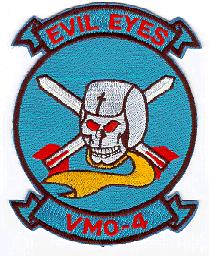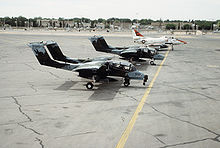
Marine Light Attack Helicopter Squadron 367 (HMLA-367) is a United States Marine Corps helicopter squadron consisting of AH-1Z Viper attack helicopters and UH-1Y Venom utility helicopters. Originally commissioned during World War II, the squadron participated in combat operations on Peleliu and Okinawa. Reactivated during the Vietnam War, the squadron has served during numerous conflicts since. The squadron is based at Marine Corps Air Station Camp Pendleton, California and falls under the command of Marine Aircraft Group 39 (MAG-39) and the 3rd Marine Aircraft Wing.
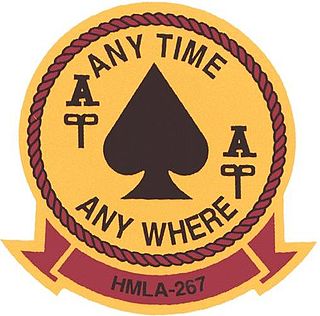
Marine Light Attack Helicopter Squadron 267 (HMLA-267) is a United States Marine Corps helicopter squadron consisting of Bell AH-1Z Viper attack helicopters and Bell UH-1Y Venom utility helicopters. Nicknamed the "Stingers", the squadron is based at Marine Corps Base Camp Pendleton, California and falls under the command of Marine Aircraft Group 39 (MAG-39) and the 3rd Marine Aircraft Wing.

Marine Aircraft Group 13 is a United States Marine Corps aviation unit based at Marine Corps Air Station Yuma that is currently composed of one McDonnell Douglas AV-8B Harrier II squadron, three Lockheed Martin F-35B Lightning II squadrons, an unmanned aerial vehicle squadron, a maintenance and logistics squadron, and a wing support squadron. The group falls under the command of the 3rd Marine Aircraft Wing and the I Marine Expeditionary Force.
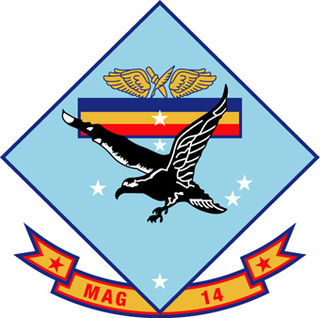
Marine Aircraft Group 14 (MAG-14) is a United States Marine Corps aviation unit based at Marine Corps Air Station Cherry Point, North Carolina that is currently composed of two AV-8B Harrier squadrons, one F-35B squadron, one UAV squadron, one KC-130 squadron, and an aviation logistics squadron.

Marine Unmanned Aerial Vehicle Squadron 1 (VMU-1) is an unmanned aerial vehicle squadron in the United States Marine Corps that operates the MQ-9A Reaper. They are based out of Marine Corps Air Station Yuma, Arizona and provide reconnaissance, surveillance, and target acquisition for the I Marine Expeditionary Force. They fall under the command of Marine Aircraft Group 13 and the 3rd Marine Aircraft Wing.
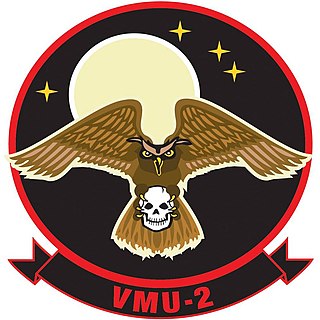
Marine Unmanned Aerial Vehicle Squadron 2 (VMU-2) is an unmanned aerial vehicle squadron in the United States Marine Corps that operates the RQ-21A Blackjack. The squadron is based at Marine Corps Air Station Cherry Point in Havelock, North Carolina and provides aerial surveillance, offensive air support, and electronic warfare for the II Marine Expeditionary Force. VMU-2 falls under the command of Marine Aircraft Group 14 and the 2nd Marine Aircraft Wing.

Marine Fighter Attack Squadron 351 (VMFA-351) was a fighter squadron in the Marine Forces Reserve. The squadron was based at Naval Air Station Atlanta and participated in action during World War II and was decommissioned in 1975.
Marine Observation Squadron 7 (VMO-7) was an observation squadron of the United States Marine Corps during World War II. They were active for a year and a half during which time they saw action during the Battle of Okinawa. The squadron was quickly deactivated following the end of the war.
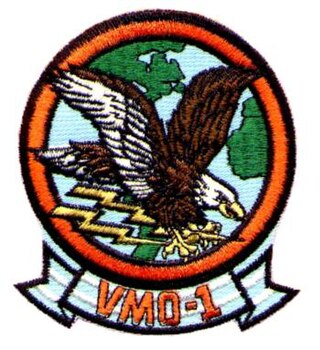
Marine Observation Squadron 1 (VMO-1) was an observation squadron of the United States Marine Corps which saw extensive action during World War II and supported numerous contingencies during the Cold War. They were based at Marine Corps Air Station New River, North Carolina and saw their final deployment in support of Operation Desert Storm in 1991. They were deactivated on July 31, 1993.
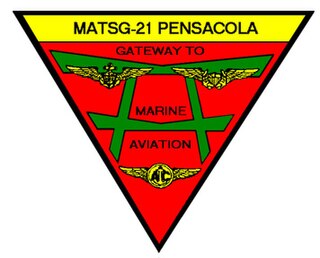
Marine Aviation and Training Support Group 21 (MATSG-21) is a United States Marine Corps aviation training group that was originally established in 1922 as the 2nd Aviation Group. During World War II the unit was known as Marine Aircraft Group 21 (MAG-21). Squadrons from MAG-21 fought in many of the opening battles of the war to include the Battle of Wake Island, Battle of Midway and as part of the Cactus Air Force during the Battle of Guadalcanal The group was deactivated following the end of the war and was not reactivated until 2000 when the Marine Aviation Detachment at Naval Air Station Pensacola, Florida was renamed MATSG-21. The core of the MATSG personnel is derived from 175 officer instructors and 550 student naval aviators/naval flight officers.
Marine Aircraft Group 93 (MAG-93) was a United States Marine Corps aviation group established during World War II. MAG-93, a dive bombing training group, was commissioned on 1 April 1944 and was initially headquartered at Marine Corps Auxiliary Airfield Bogue, North Carolina. Their mission was to train pilots to fly the Curtiss SB2C Helldiver. The group was decommissioned in October 1945 as part of the post-war drawdown of forces and has been inactive since.
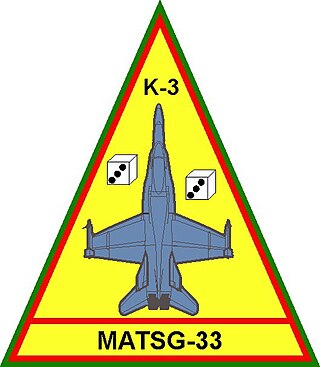
Marine Aviation and Training Support Group 33 (MATSG-33) is a United States Marine Corps aviation training group that was originally established during World War II as Marine Aircraft Group 33 (MAG-33). Fighter squadrons from MAG-33 fought most notably during the Battle of Okinawa and also as the first Marine aviation units to support the Korean War when they arrived as part of the 1st Provisional Marine Brigade. They helped stabilize the United Nations positions during the Battle of Pusan Perimeter and fought in Korea for the remainder of the war. At some point in the 1960s, the group was deactivated and was not reactivated until 2000, when Marine Aviation Training Support Group at Naval Air Station Oceana, Virginia was renamed MATSG-33.

Marine Corps Air Station Camp Pendleton or MCAS Camp Pendleton is a United States Marine Corps airfield located within Marine Corps Base Camp Pendleton, California. It was commissioned in 1942 and is currently home to Marine Aircraft Group 39. The airfield is also known as Munn Field in honor of Lieutenant General John C. "Toby" Munn, the first Marine aviator to serve as the Commanding General of Marine Corps Base Camp Pendleton.

Marine Torpedo Bombing Squadron 151 (VMTB-151) was a dive bombing squadron in the United States Marine Corps. The squadron fought in World War II but was quickly deactivated after the war on March 20, 1946.

Marine Fighting Squadron 215 (VMF-215) was a fighter squadron of the United States Marine Corps that was commissioned and fought during World War II. Known as "The Fighting Corsairs", the squadron fought in many areas of the Pacific War, including the Battle of Bougainville. During its four-and-a-half month tour, the squadron was credited with shooting down 137 enemy aircraft, fourth most in Marine Corps aviation history.
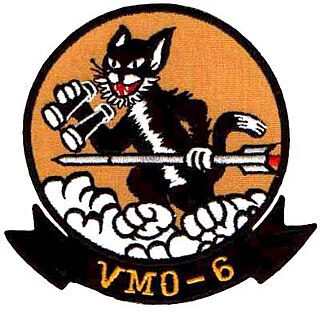
Marine Observation Squadron 6 (VMO-6) was an observation squadron of the United States Marine Corps which saw extensive action during the Battle of Okinawa in World War II and the Korean and Vietnam Wars. The squadron was the first Marine Corps helicopter squadron to participate in combat operations when it participated in the Battle of Pusan Perimeter in August 1950. The squadron was decommissioned on January 1, 1977.
Marine Fighting Squadron 413 (VMF-413) was a fighter squadron of the Marine Forces Reserve during the Cold War. It descended from bombing squadron VMB-413, which was the Marine Corps' first medium bomber squadron and had fought during World War II. Best known as “Night Hecklers” and the “Shamrocks”, the squadron fought in many areas of the Pacific War.

Marine Fighting Squadron 511 (VMF-511) was a fighter squadron of the Marine Corps and Marine Forces Reserve during World War II and the Cold War which flew aircraft types such as the F6F Hellcat, F4U Corsair, and the F-8 Crusader. They were originally activated during World War II and fought during the Battle of Okinawa and the Battle of Balikpapan (1945). They specialized in close air support and during the course of the war were credited with only one plane shot down.
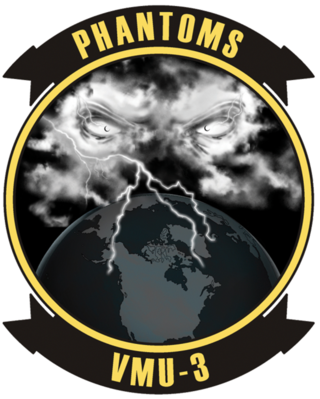
Marine Unmanned Aerial Vehicle Squadron 3 is an unmanned aerial vehicle (UAV) squadron in the United States Marine Corps that operates the RQ-21 Blackjack that consists of approximately 200 Marines. They are based out of Marine Corps Base Hawaii, Kaneohe Bay, Hawaii and its primary mission is to provide aerial surveillance for the III Marine Expeditionary Force. The unit also provides Reconnaissance, Surveillance, and Target Acquisition (RSTA) to units participating in Mojave Viper, an exercise held several times a year in 29 Palms, CA. The squadron, nicknamed the Phantoms, was activated on September 12, 2008 and falls under the command of Marine Aircraft Group 24 and the 1st Marine Aircraft Wing.

Marine Observation Squadron 2 (VMO-2) was an observation squadron of the United States Marine Corps which saw extensive action during World War II and the Vietnam War. They were based at Marine Corps Air Station Futenma, Japan and Marine Corps Air Station Camp Pendleton, California and saw their final combat in support of Operation Desert Storm in 1991. The squadron was decommissioned on May 23, 1993.

